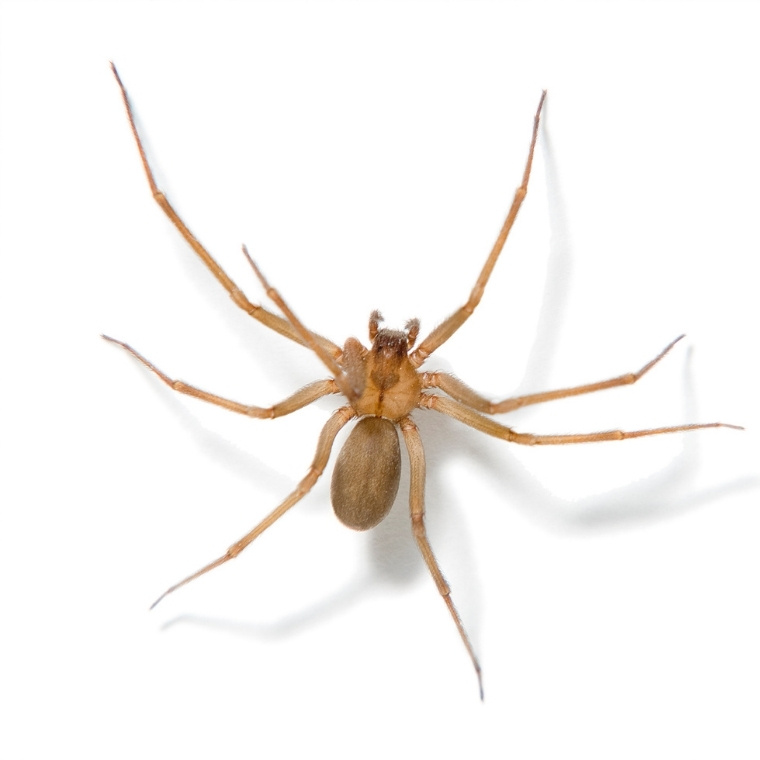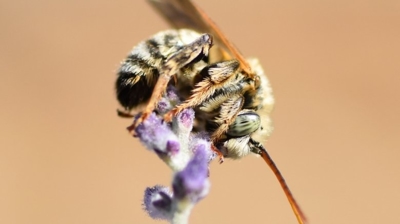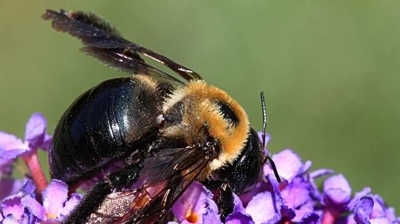
Brown Recluse Spider Control Services

Are Brown Recluse Spiders Harmful?
Brown recluse spiders (Loxosceles reclusa) can pose several potential risks to human health and well-being, though they are not typically aggressive. Here are the main ways in which they can be harmful:
- Venomous Bite: The most significant danger comes from their venom, which contains a potent enzyme called sphingomyelinase D. This enzyme can cause cell damage and break down blood vessels, leading to tissue necrosis. While brown recluse spiders generally avoid human contact and will only bite in self-defense, a bite can lead to serious health issues.
- Necrotic Skin Lesions: The venom can cause a condition called necrotizing fasciitis, resulting in a deep, ulcerative wound at the site of the bite. The wound may initially look mild, but it can expand over time and become severely painful. In severe cases, the skin and underlying tissue may die, leading to scarring and possible infections.
- Allergic Reactions: Some individuals may have allergic reactions to the venom, leading to swelling, difficulty breathing, or anaphylaxis in severe cases. This is less common but still a potential risk.
- Systemic Reactions: Although rare, the venom of a brown recluse spider can sometimes cause systemic reactions. This can include fever, chills, nausea, vomiting, joint pain, and weakness. In extreme cases, it may lead to hemolysis (destruction of red blood cells), kidney failure, or even death, particularly in individuals who have compromised immune systems or are very young or elderly.
- Psychological Impact: The fear of encountering a brown recluse can cause significant anxiety in people who live in areas where the spiders are found. This fear may lead to unnecessary avoidance behaviors or excessive concern over bites, even when none have occurred.
Although these spiders are dangerous in certain situations, bites are rare, and fatalities are even rarer.
Learn more: Do Brown Recluse Spiders Bite?
Learn more: Are Brown Recluse Spiders Poisonous?
Brown Recluse Spider Control
Hiring our professional pest control for brown recluse spiders is strongly recommended because these spiders are highly venomous, difficult to detect, and often hide in hard-to-reach areas. Here’s why our professional intervention is the safest and most effective option:
- Identification Expertise: Brown recluse spiders are often confused with other harmless spiders. Our professionals can accurately identify brown recluses based on their distinct violin-shaped marking, size, and webbing patterns. Misidentification can lead to improper treatment or unnecessary fear.
- Safety Concerns: Brown recluse bites can cause serious medical complications, including necrotic skin lesions and infections. Attempting DIY removal puts you at risk of bites. Our professionals have the training, protective equipment, and knowledge to handle infestations safely.
- Effective Treatment: These spiders are reclusive and tend to hide in undisturbed areas such as attics, basements, closets, and behind furniture. Our professional exterminators use targeted treatments, including residual insecticides and strategic placement, that are more effective than over-the-counter sprays. We also know how to treat potential entry points to prevent reinfestation.
- Long-Term Prevention: Our professionals don’t just eliminate the spiders; they assess the environment for conditions that attract them, such as clutter, gaps in doors or windows, and rodent activity (which can bring in prey for the spiders). We can recommend or implement measures to make your home less hospitable to brown recluses over the long term.
- Peace of Mind: Even a small population of brown recluse spiders can cause constant stress because they are nocturnal and rarely seen until a bite occurs. Hiring our experts ensures a thorough inspection, treatment, and follow-up, giving you confidence that your home is safe.
- Time and Efficiency: Our professional exterminators can locate nests and spider activity more quickly than a homeowner could on their own. DIY methods often require repeated attempts with limited effectiveness, whereas our professionals use proven strategies to resolve infestations efficiently.
Brown recluse spiders are not only dangerous but notoriously elusive. Our professional pest control ensures accurate identification, safe removal, effective treatment, and long-term prevention—something DIY approaches rarely achieve.
Learn more: How To Get Rid Of Brown Recluse Spiders
Brown Recluse Spider Appearance
Brown recluse spiders (Loxosceles reclusa) are known for their distinctive appearance, which includes several key features that can help you identify them:
- Size: Brown recluse spiders are relatively small, with a body length typically ranging from 6 to 20 millimeters (about 1/4 to 3/4 inches). This size can make them appear smaller than many other common spider species.
- Color: As their name suggests, brown recluse spiders are usually brown, but the exact shade of brown can vary. They can range from a pale, yellowish-brown to a dark, reddish-brown color. Their legs are typically lighter in color than their bodies.
- Violin-Shaped Marking: One of the most distinctive features of brown recluse spiders is the violin-shaped marking on their cephalothorax (the front part of their body). This marking is dark brown and has a distinctive shape, with the "neck" of the violin pointing toward the rear of the spider. This feature is why they are sometimes referred to as "violin spiders" or "fiddleback spiders."
- Eye Arrangement: Brown recluse spiders have six eyes, arranged in pairs. These eyes are not as prominent as those of some other spider species and can be difficult to see without magnification.
- Legs: They have long, slender legs with fine hairs. The legs of brown recluse spiders are usually uniform in color and lack distinct banding or striping.
- Abdomen: The abdomen of a brown recluse spider is oval-shaped and lacks the bright, contrasting patterns or markings seen in many other spider species.
While the violin-shaped marking is a key characteristic, it's not always easy to see, especially from a distance or without close inspection. Additionally, the coloration of brown recluse spiders can vary, and some individuals may appear darker or lighter than the typical description.
Identifying a brown recluse spider by its appearance alone can be challenging, and it's important to exercise caution and not rely solely on visual cues. If you suspect you've encountered a brown recluse spider and are concerned about a potential bite, it's best to contact a pest control professional or a knowledgeable expert for proper identification and guidance.
Learn more: What Do Brown Recluse Spiders Look Like?
Learn more: Wolf Spiders vs Brown Recluse Spiders
Learn more: What Does A Brown Recluse Bite Look Like?
Where Are Brown Recluse Spiders Found?
Brown recluse spiders (Loxosceles reclusa) are primarily found in certain regions of the United States, and their distribution is mainly concentrated in the central and southern parts of the country. These spiders tend to inhabit specific types of environments and seek out secluded areas. Here are some common places where you might find brown recluse spiders:
- Southern and Central United States: Brown recluse spiders are most commonly found in the central and southern United States. States like Texas, Oklahoma, Missouri, Arkansas, Kansas, and parts of the Southeast have higher populations of these spiders.
- Indoor Hiding Spots: Brown recluse spiders are reclusive by nature and prefer to stay hidden. They are often found indoors in quiet, undisturbed areas, such as: closets, attics, basements, crawl spaces, wall voids, and behind or inside stored items like boxes, furniture, and clothing.
- Outdoor Environments: While brown recluse spiders are primarily indoor dwellers, they may also be found in outdoor locations, particularly in rural or suburban areas. Common outdoor hiding places include: woodpiles, sheds and outbuildings, garages, under debris or rocks, and in tree bark crevices.
- Dark and Sheltered Nooks: These spiders prefer dark, sheltered environments, so they may hide in cracks, crevices, and corners. They often create irregular, messy webs in these secluded areas.
- Human-made Structures: Brown recluse spiders can be found in homes, barns, warehouses, and other human-made structures that provide suitable hiding spots and access to prey.
- Cluttered Areas: Cluttered and rarely disturbed spaces are ideal hiding spots for brown recluse spiders. Keeping your living spaces organized and clutter-free can help reduce the likelihood of encountering them.
- Warm Seasons: Brown recluse spiders are more active during the warmer months of the year, so sightings may be more common in spring and summer.
Exercise caution when inspecting potential hiding spots for brown recluse spiders, as they may bite if they feel threatened or cornered. If you suspect the presence of brown recluse spiders in your home or property, it's advisable to contact our team of pest control professionals for proper identification and, if necessary, safe removal. Additionally, taking preventive measures, such as sealing cracks and crevices, can help reduce the likelihood of brown recluse spiders establishing themselves in your living spaces.
Brown Recluse Spider Diet
Brown recluse spiders (Loxosceles reclusa) are carnivorous and primarily feed on insects and other small arthropods. Their diet consists of a variety of prey items that they can capture in or near their webs. Here is a detailed explanation of what brown recluse spiders eat:
- Insects: Brown recluse spiders are skilled hunters and use their silk threads to create irregular, messy webs in hidden, sheltered locations. They do not spin the classic orb-shaped webs seen in some other spider species. Instead, they construct loose, sticky webs in areas like closets, attics, basements, and woodpiles. When insects such as flies, moths, beetles, and ants inadvertently come into contact with these webs, they become trapped.
- Other Arachnids: Brown recluse spiders are not limited to insects and will also consume other arachnids, such as small spiders. If a fellow spider gets caught in their web, the brown recluse spider may feed on it.
- Prey Size: Brown recluse spiders are opportunistic predators and will eat prey that is suitable for their size. They do not actively hunt down large prey but prefer smaller arthropods that are easy to subdue and consume.
- Cannibalism: In cases of limited food availability or overcrowding, brown recluse spiders may resort to cannibalism, where they may eat other brown recluse spiders, especially if they encounter them in their hiding spots.
- Scavenging: Brown recluse spiders are known to be scavengers as well. They may feed on dead insects or other organic matter they find in their environment.
Brown recluse spiders are not aggressive toward humans and do not typically see humans as prey. Bites from brown recluse spiders are rare and usually occur when the spider feels threatened or trapped, such as when it is accidentally pressed against the skin.
Learn more: What Do Brown Recluse Spiders Eat?
Brown Recluse Spider Life Cycle
The life cycle of the brown recluse spider (Loxosceles reclusa) is typical of most spiders and consists of several distinct stages, including egg, spiderling, juvenile, and adult. Here's an overview of the brown recluse spider's life cycle:
- Egg Stage: The life cycle begins with the female brown recluse spider laying eggs. She constructs a silken egg sac, which is typically off-white to light tan in color. The female attaches the egg sac to a protected surface, such as a web, a corner of her retreat, or a hidden area in a human-made structure. Each egg sac contains multiple eggs, and a single female may produce several egg sacs during her lifetime.
- Spiderling Stage: After an incubation period of approximately 2 to 4 weeks, spiderlings hatch from the eggs. Spiderlings are tiny and resemble miniature versions of adult brown recluse spiders. At this stage, they are fully independent and must fend for themselves, as they do not receive parental care.
- Juvenile Stage: As spiderlings grow, they go through a series of molts, shedding their exoskeletons to accommodate their increasing size. Brown recluse spiderlings resemble adults in body shape but are smaller and lack the distinct violin-shaped marking on their cephalothorax. The juvenile stage can last several months, and the exact number of molts can vary among individuals.
- Adult Stage: Once spiderlings reach maturity, they enter the adult stage. The timing of maturation can depend on various factors, including food availability and environmental conditions. Adult brown recluse spiders typically measure between 6 to 20 millimeters (approximately 1/4 to 3/4 inches) in body length. They have the characteristic violin-shaped marking on their cephalothorax, which distinguishes them from other spiders in the region. Brown recluse spiders are sexually dimorphic, with females generally being slightly larger than males.
- Reproduction: Adult brown recluse spiders are capable of reproducing through mating. Males use silk threads to create sperm webs, deposit sperm on these webs, and then transfer the sperm to their pedipalps (sensory appendages) for mating. Mating typically occurs during the warmer months of the year. After mating, females will lay eggs in silken egg sacs, and the life cycle continues.
- Lifespan: Brown recluse spiders can live for several years in favorable conditions, with females generally having longer lifespans than males. Their life cycle and behavior are adapted to a secretive and reclusive lifestyle, which includes staying hidden during the day and actively foraging for prey at night. While they are known for their venomous bite, encounters with brown recluse spiders are relatively rare, and most interactions with them are non-confrontational.
Learn more: Do Wolf Spiders Eat Brown Recluse Spiders?

Hear From Our Happy Customers
-
"Wonderful Service"
Wonderful service. Jarvis is great. Took care of everything I needed. Thank you!
- Henry P. -
"Professional & Considerate"
I’m pleased with Miche services. Jarvis came today. Professional and considerate. Thank you!
- Judy B. -
"Great Communication"
Tech was on time, communication was great, and he accommodated my needs.
- Alonzo W. -
"Fantastic & Patient"
Jarvis was fantastic and patient. He answered my questions with an in-depth explanation and addressed all of my areas of concern. Would love for him to be my assigned tech going forward. Well done!
- Yonnette M. -
"Very Knowledgeable"
The tech that arrived was courteous, professional, and very knowledgeable. He was Great.
- Uerial I. -
"Exceeds Expectations"
I can’t say enough positive things about this company... The tech that came out, Jarvis went above and beyond my expectations. Thank you guys, I will continue using your services.
- Jake M.



